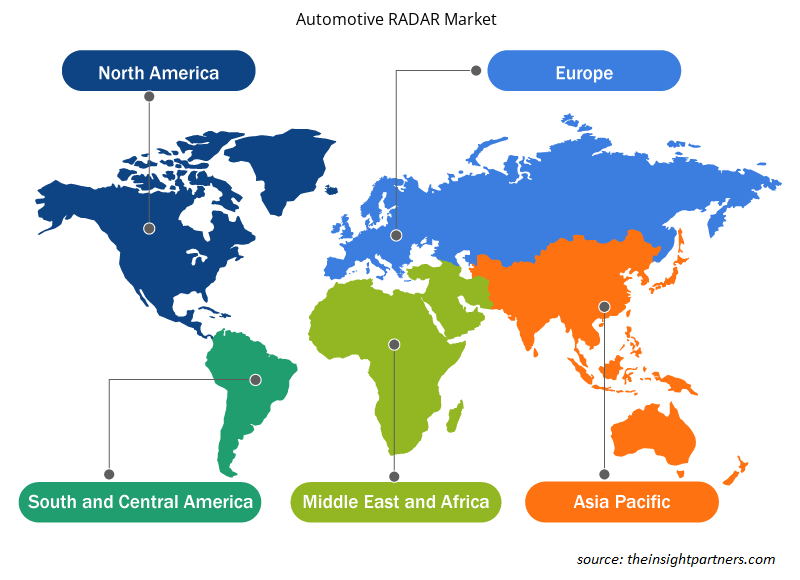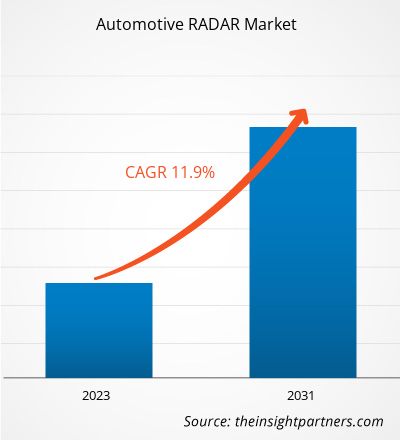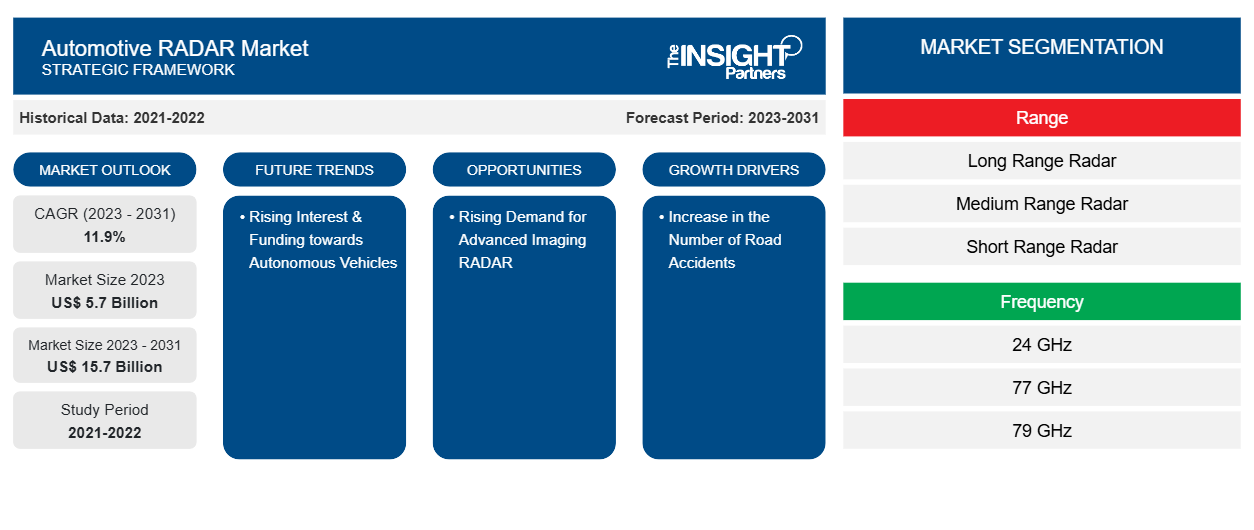Der Markt für Automotive-RADAR soll von 5,7 Milliarden US-Dollar im Jahr 2023 auf 15,7 Milliarden US-Dollar im Jahr 2031 anwachsen. Der Markt soll in den Jahren 2023–2031 eine durchschnittliche jährliche Wachstumsrate von 11,9 % verzeichnen. Der zunehmende Einsatz von Automotive-RADAR in fortschrittlichen Fahrerassistenzsystemen, um Funktionen wie adaptive Geschwindigkeitsregelung (ACS), Spurwechselassistent, Notbremsung, Totwinkelerkennung und andere bereitzustellen, ist einer der Hauptfaktoren, die das Wachstum des Automotive-RADAR-Marktes vorantreiben.
Automotive-RADAR-Marktanalyse
Der Markt für Kfz-Radare dürfte im analysierten Zeitraum aufgrund zunehmender staatlicher Vorschriften zur Fahrzeugsicherheit, der zunehmenden Verbreitung von Premiumfahrzeugen und der wachsenden Anzahl von Radaren in Fahrzeugen ein beträchtliches Wachstum erfahren. Darüber hinaus wird erwartet, dass die zunehmende Produktion und Verbreitung von Elektrofahrzeugen (EVs) das Wachstum des Marktes für Kfz-Radare weiter unterstützen wird. Es wird erwartet, dass autonomes Fahren in den nächsten Jahren ein wachsender Trend sein wird. Um dies zu erreichen, wurden mehrere Bildverarbeitungstechnologien entwickelt, die den Fahrern und Passagieren des Fahrzeugs Funktionalität und Sicherheit bieten sollen.
Automotive-RADAR-Marktübersicht
Radarsysteme sind die etabliertesten und vertrauenswürdigsten Technologien in den verschiedenen Sichttechnologien der Automobilindustrie. Derzeit sind mehrere Fahrzeughersteller damit beschäftigt, Automatisierungstechnologie der Stufe 3 bereitzustellen, bei der die Fahrer für eine bestimmte Zeit in Bereitschaft sind. Diese Fahrzeuge sind mit fünf Radarsystemen ausgestattet, darunter SSR und LLR, für Anwendungen wie Notbremsung oder adaptive Geschwindigkeitsregelung. Darüber hinaus wird erwartet, dass die hohe Nachfrage nach Radartechnologie in der Automobilindustrie aufgrund der damit verbundenen Vorteile, darunter Allwetterleistung, direkte Geschwindigkeitsmessung, Erkennung ohne Sichtverbindung, Erschwinglichkeit und andere, den Markt im Prognosezeitraum antreiben wird.
Passen Sie diesen Bericht Ihren Anforderungen an
Sie erhalten kostenlose Anpassungen an jedem Bericht, einschließlich Teilen dieses Berichts oder einer Analyse auf Länderebene, eines Excel-Datenpakets sowie tolle Angebote und Rabatte für Start-ups und Universitäten.
- Holen Sie sich die wichtigsten Markttrends aus diesem Bericht.Dieses KOSTENLOSE Beispiel umfasst eine Datenanalyse von Markttrends bis hin zu Schätzungen und Prognosen.
Automotive RADAR Markttreiber und Chancen
Zunahme der Zahl der Verkehrsunfälle.
Verkehrsunfälle sind ein zentrales öffentliches Problem für Regierungen auf der ganzen Welt, und die zunehmende Zahl der Verkehrsunfälle behindert die Marktentwicklung in diesen Ländern. Laut Angaben der Weltgesundheitsorganisation (WHO) sterben fast 1,19 Millionen Menschen durch Verkehrsunfälle. Die meisten Verkehrsunfälle ereignen sich in Entwicklungs- und Industrieländern und sind auf menschliche Fahrfehler zurückzuführen. Obwohl sich die Fahrzeugsicherheitstechnologie in den letzten Jahrzehnten mit der Einführung fortschrittlicher Fahrerassistenzsysteme (ADAS) und der Aussicht auf autonome Fahrzeuge deutlich verbessert hat, zeigen diese Zahlen, dass die Fahrzeugsicherheit viel schneller verbessert werden muss, und legen nahe, dass die Einführung automatisierter Fahrtechnologien dazu beitragen kann, die Zahl der Todesopfer drastisch zu senken, indem menschliche Fahrfehler aus der Gleichung eliminiert werden. Daher wird erwartet, dass der Anstieg der Zahl der Verkehrsunfälle die Nachfrage nach Radarsystemen für Kraftfahrzeuge ankurbelt, was wiederum das Marktwachstum in den kommenden Jahren ankurbeln wird.
Steigende Nachfrage nach fortschrittlichem Bildgebungsradar
Mit der steigenden Zahl von Fahrzeugen der Stufe 2+ auf den Straßen steigt der Bedarf an fortschrittlicheren und präziseren Radarsensoren für Kraftfahrzeuge. Dies ist eine große Chance für OEMs, Radarsensoren auf Basisniveau anzubieten. So haben Xilinx und Continental beispielsweise das erste produktionsreife 4D-Bildgebungsradar angekündigt. Theoretisch verwendet das 4D-Bildgebungsradar Echoortung (ein Mechanismus, der bei Delfinen, Fledermäusen und mehreren Menschen beobachtet wird) und das Laufzeitmessprinzip, um einen Raum in 3D zu erfassen. Darüber hinaus sind diese Radarsysteme so konzipiert, dass sie die Bildgebungsanforderungen innerhalb der Zeitskala eines schnell fahrenden Autos oder einer heransausenden Drohne erfüllen. Daher verbessert die vierte Dimension die Gesamtgenauigkeit eines selbstfahrenden Systems. Das 4D-Bildgebungsradar ist bei allen Wetter-/Umweltbedingungen einsatzbereit, einschließlich Nebel, Dunkelheit und starkem Regen. Zahlreiche Unternehmen investieren in Forschung und Entwicklung, um solche fortschrittlichen radarbasierten Bildgebungstechnologien einzuführen und einen maximalen Anteil am globalen Markt für Automobilradare zu gewinnen.OEMs to offer basic-level radar sensors. For instance, Xilinx and Continental announced the first production-ready 4D imaging radar. Theoretically, 4D imaging radar uses echolocation (a mechanism that is observed in dolphins, bats, and several humans) and the time-of-flight measurement principle to capture a space in 3D. Furthermore, these
Automotive RADAR Marktbericht Segmentierungsanalyse
Wichtige Segmente, die zur Ableitung der Automotive-RADAR-Marktanalyse beigetragen haben, sind Reichweite, Frequenz, Anwendung und Fahrzeugtyp.
- Basierend auf der Reichweite wurde der Automotive-RADAR-Markt in Long Range Radar (LRR), Medium Range Radar (MRR) und Short Range Radar (SRR) unterteilt. Das Segment der Kurzstreckenradare hatte im Jahr 2023 einen größeren Marktanteil.LRR), Medium Range Radar(MRR), and Short Range Radar (SRR)). The short-range radar segment held a larger market share in 2023.
- Basierend auf der Frequenz wurde der Automotive-RADAR-Markt in 24 GHz, 77 GHz und 79 GHz unterteilt. Das 77-GHz-Segment hatte im Jahr 2023 einen größeren Marktanteil.
- Auf der Grundlage der Anwendung wurde der Markt in adaptive Geschwindigkeitsregelung (ACS), autonome Notbremsung, Totwinkelerkennung, Vorwärtskollisionswarnsystem, intelligente Parkhilfe und andere segmentiert. Das Segment der adaptiven Geschwindigkeitsregelung dominierte den Markt im Jahr 2023.ACS), autonomous emergency braking, blind spot detection, forward collision warning system, intelligent park assist, and others. The adaptive cruise control segment dominated the market in 2023.
- Basierend auf dem Fahrzeugtyp wurde der Automotive RADAR-Markt in Personenkraftwagen, leichte Nutzfahrzeuge sowie mittlere und schwere Nutzfahrzeuge unterteilt. Das Segment der Personenkraftwagen hatte im Jahr 2023 einen größeren Marktanteil.Thepassenger cars segment held a larger market share in 2023.
Automotive RADAR Marktanteilsanalyse nach Geografie
Der geografische Umfang des Automotive-RADAR-Marktberichts ist hauptsächlich in fünf Regionen unterteilt: Nordamerika, Europa, Asien-Pazifik, Naher Osten und Afrika sowie Südamerika.
Der asiatisch-pazifische Raum dominierte den Automotive-RADAR-Markt im Jahr 2023. Der asiatisch-pazifische Raum umfasst China, Indien, Japan, Südkorea und den Rest Europas. Regierungsinitiativen wie „Made in China 2025“ und „Made in India“ katalysieren das Wachstum des Automobilsektors in der Region. Verbesserungen der Infrastruktur, Steigerungen des Inlandsverbrauchs und niedrige Arbeitskosten in den südostasiatischen Ländern sind die Schlüsselfaktoren, die Automobilunternehmen in diese Region locken. Darüber hinaus wird erwartet, dass ein Anstieg der Investitionen in Forschung und Entwicklung von Automobiltechnologien das Wachstum des Automotive-RADAR-Marktes in den kommenden Jahren ankurbeln wird. Darüber hinaus wird erwartet, dass die zunehmenden Bemühungen der Automobilgiganten zur Optimierung automatisierter Autos den Verkauf von Elektrofahrzeugen in APAC-Ländern wie Indien, Malaysia, Singapur und Thailand deutlich ankurbeln werden. So investierte das US-amerikanische Unternehmen Magna International im Oktober 2022 mehr als 120 Millionen US-Dollar in die Einrichtung und den Betrieb neuer Entwicklungszentren in Bengaluru, Indien.APAC countries such as India, Malaysia, Singapore, and Thailand. For instance, in October 2022, the US-based company named Magna International invested more than US$ 120 million in establishing and operating new engineering centers in Bengaluru, India.
Regionale Einblicke in den Automotive RADAR-Markt
Die regionalen Trends und Faktoren, die den Automotive RADAR-Markt während des gesamten Prognosezeitraums beeinflussen, wurden von den Analysten von Insight Partners ausführlich erläutert. In diesem Abschnitt werden auch Automotive RADAR-Marktsegmente und -Geografie in Nordamerika, Europa, im asiatisch-pazifischen Raum, im Nahen Osten und Afrika sowie in Süd- und Mittelamerika erörtert.

- Erhalten Sie regionale Daten zum Automotive-RADAR-Markt
Umfang des Automotive-RADAR-Marktberichts
| Berichtsattribut | Details |
|---|---|
| Marktgröße im Jahr 2023 | 5,7 Milliarden US-Dollar |
| Marktgröße bis 2031 | 15,7 Milliarden US-Dollar |
| Globale CAGR (2023 - 2031) | 11,9 % |
| Historische Daten | 2021-2022 |
| Prognosezeitraum | 2023–2031 |
| Abgedeckte Segmente | Nach Sortiment
|
| Abgedeckte Regionen und Länder | Nordamerika
|
| Marktführer und wichtige Unternehmensprofile |
|
Automotive RADAR – Marktteilnehmerdichte: Die Auswirkungen auf die Geschäftsdynamik verstehen
Der Automotive-RADAR-Markt wächst rasant, angetrieben durch die steigende Endverbrauchernachfrage aufgrund von Faktoren wie sich entwickelnden Verbraucherpräferenzen, technologischen Fortschritten und einem größeren Bewusstsein für die Vorteile des Produkts. Mit steigender Nachfrage erweitern Unternehmen ihr Angebot, entwickeln Innovationen, um die Bedürfnisse der Verbraucher zu erfüllen, und nutzen neue Trends, was das Marktwachstum weiter ankurbelt.
Die Marktteilnehmerdichte bezieht sich auf die Verteilung von Firmen oder Unternehmen, die in einem bestimmten Markt oder einer bestimmten Branche tätig sind. Sie gibt an, wie viele Wettbewerber (Marktteilnehmer) in einem bestimmten Marktraum im Verhältnis zu seiner Größe oder seinem gesamten Marktwert präsent sind.
Die wichtigsten auf dem Automobil-Radar-Markt tätigen Unternehmen sind:
- Robert Bosch GmbH
- Continental AG
- Denso Corporation
- Aptiv Plc
- Hella GmbH & Co. KGaA
- Valeo
Haftungsausschluss : Die oben aufgeführten Unternehmen sind nicht in einer bestimmten Reihenfolge aufgeführt.

- Erhalten Sie einen Überblick über die wichtigsten Akteure des Automotive RADAR-Marktes
Automotive RADAR – Marktnachrichten und aktuelle Entwicklungen
Der Automotive-RADAR-Markt wird durch die Erfassung qualitativer und quantitativer Daten nach Primär- und Sekundärforschung bewertet, die wichtige Unternehmensveröffentlichungen, Verbandsdaten und Datenbanken umfasst. Im Folgenden finden Sie eine Liste der Entwicklungen auf dem Automotive-RADAR-Markt und der Strategien:
- Im Januar 2021 stellte das Unternehmen eine Plattform für Fahrerassistenzsysteme (ADAS) der nächsten Generation mit Level 1-3 vor. Diese ADAS-Lösung ist kostengünstig und effizient und stärkt somit das Produktportfolio des Unternehmens.
- Im September 2023 ging Valeo eine Partnerschaft mit Mobileye ein. Ziel dieser Partnerschaft war die Entwicklung softwaredefinierter, erstklassiger Bildradare für Fahrerassistenz- und automatisierte Fahrfunktionen der nächsten Generation.
Abdeckung und Ergebnisse des Automotive-RADAR-Marktberichts
Der Bericht „Automotive RADAR-Marktgröße und -prognose (2021–2031)“ bietet eine detaillierte Analyse des Marktes, die die folgenden Bereiche abdeckt:
- Marktgröße und Prognose auf globaler, regionaler und Länderebene für alle wichtigen Marktsegmente, die im Rahmen des Projekts abgedeckt sind
- Marktdynamik wie Treiber, Beschränkungen und wichtige Chancen
- Wichtige Zukunftstrends
- Detaillierte Porter's Five Forces Analyse
- Globale und regionale Marktanalyse mit wichtigen Markttrends, wichtigen Akteuren, Vorschriften und aktuellen Marktentwicklungen
- Branchenlandschaft und Wettbewerbsanalyse, einschließlich Marktkonzentration, Heatmap-Analyse, prominenten Akteuren und aktuellen Entwicklungen
- Detaillierte Firmenprofile mit SWOT-Analyse
- Historische Analyse (2 Jahre), Basisjahr, Prognose (7 Jahre) mit CAGR
- PEST- und SWOT-Analyse
- Marktgröße Wert/Volumen – Global, Regional, Land
- Branchen- und Wettbewerbslandschaft
- Excel-Datensatz
Aktuelle Berichte
Verwandte Berichte
Erfahrungsberichte
Grund zum Kauf
- Fundierte Entscheidungsfindung
- Marktdynamik verstehen
- Wettbewerbsanalyse
- Kundeneinblicke
- Marktprognosen
- Risikominimierung
- Strategische Planung
- Investitionsbegründung
- Identifizierung neuer Märkte
- Verbesserung von Marketingstrategien
- Steigerung der Betriebseffizienz
- Anpassung an regulatorische Trends























 Kostenlose Probe anfordern für - Automotive RADAR-Markt
Kostenlose Probe anfordern für - Automotive RADAR-Markt